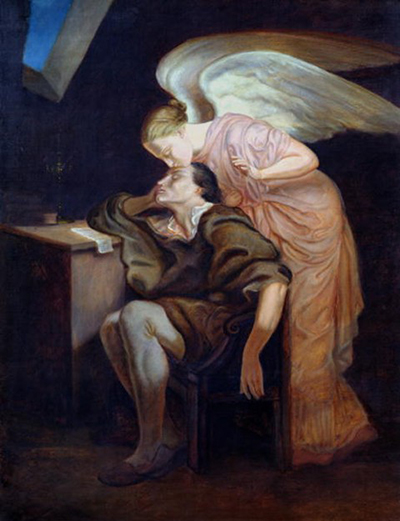Also called Dream of the Poet, The Kiss of the Muse is an oil on canvas piece that Paul Cézanne did between 1859 and 1860.
It is one of the 22 copies that the French artist did over the span of his career. He copied the painting after Neoclassicist artist Felix Frillié at the Museé Granet. Cézanne used the Romanticism style for this painting, emphasising heavily on symbolism.
The Poet Who Needs Inspiration
In The Kiss of the Muse, Cézanne presents a man, who is a poet, sprawled on a chair. He has one hand resting on top of a desk in front of him. His head is resting awkwardly on the palm of his hand. The other hand drops almost lifelessly on the arm of the chair. He is draped in a pale green robe with a white tunic visible underneath. A museum is standing right behind him, bent slightly to kiss his forehead.
She adorns a pale pink gown that flows from top to bottom to cover her feet. The museum has immaculate, white wings. The two are set in what seems like an attic. A small window on the side lets in natural light from the clear blue sky. The angle of the window let the light fall on the face of the poet and the muse. It balances the darkness occupies the rest of the room.
The Kiss of the Poet shows a poet who is experiencing difficulty in his writing process. Although the scene doesn't include a writing implement, a piece of paper is resting on the desk. It appears as if the poet was in the middle of creating a poem and got stuck. Exasperation is written all over his face. His entire form screams of a man tired of what he is doing. Dream of a Poet is an apt alternate title for the painting because it describes this scene perfectly. The poet and his eyes closed so the muse on his shoulders could be part of a dream.
Symbolism at Work
In his younger years, Cézanne was consumed with composing poetry and at one time considered venturing into the field. This piece seems to be a tribute to that life. Besides the obvious image of a muse inspiring a poet, the painting appears to hold a deeper meaning. Cézanne used symbolism in many of his paintings. Here, the defeated demeanour of the poet could represent how Cézanne faired during his early days as an artist. It looks as if he has lost hope until a muse bestows inspiration. It took a while for the French painter to gain recognition for his talent and maybe a muse of inspiration had something to do with it. The Kiss of the Muse is at the Musee d'Orsay in Paris, France.




